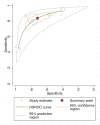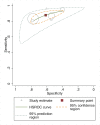Treatment of infections in young infants in low- and middle-income countries: a systematic review and meta-analysis of frontline health worker diagnosis and antibiotic access
- PMID: 25314011
- PMCID: PMC4196753
- DOI: 10.1371/journal.pmed.1001741
Treatment of infections in young infants in low- and middle-income countries: a systematic review and meta-analysis of frontline health worker diagnosis and antibiotic access
Abstract
Background: Inadequate illness recognition and access to antibiotics contribute to high case fatality from infections in young infants (<2 months) in low- and middle-income countries (LMICs). We aimed to address three questions regarding access to treatment for young infant infections in LMICs: (1) Can frontline health workers accurately diagnose possible bacterial infection (pBI)?; (2) How available and affordable are antibiotics?; (3) How often are antibiotics procured without a prescription?
Methods and findings: We searched PubMed, Embase, WHO/Health Action International (HAI), databases, service provision assessments (SPAs), Demographic and Health Surveys, Multiple Indicator Cluster Surveys, and grey literature with no date restriction until May 2014. Data were identified from 37 published studies, 46 HAI national surveys, and eight SPAs. For study question 1, meta-analysis showed that clinical sign-based algorithms predicted bacterial infection in young infants with high sensitivity (87%, 95% CI 82%-91%) and lower specificity (62%, 95% CI 48%-75%) (six studies, n = 14,254). Frontline health workers diagnosed pBI in young infants with an average sensitivity of 82% (95% CI 76%-88%) and specificity of 69% (95% CI 54%-83%) (eight studies, n = 11,857) compared to physicians. For question 2, first-line injectable agents (ampicillin, gentamicin, and penicillin) had low variable availability in first-level health facilities in Africa and South Asia. Oral amoxicillin and cotrimoxazole were widely available at low cost in most regions. For question 3, no studies on young infants were identified, however 25% of pediatric antibiotic purchases in LMICs were obtained without a prescription (11 studies, 95% CI 18%-34%), with lower rates among infants <1 year. Study limitations included potential selection bias and lack of neonatal-specific data.
Conclusions: Trained frontline health workers may screen for pBI in young infants with relatively high sensitivity and lower specificity. Availability of first-line injectable antibiotics appears low in many health facilities in Africa and Asia. Improved data and advocacy are needed to increase the availability and appropriate utilization of antibiotics for young infant infections in LMICs.
Review registration: PROSPERO International prospective register of systematic reviews (CRD42013004586). Please see later in the article for the Editors' Summary.
Conflict of interest statement
One of the authors (AHB) was an investigator on two of the studies included in the meta-analysis. However, he was not involved in the data abstraction, quality assessment or analysis. The authors otherwise declare no competing interests.
Figures







References
-
- Thaver D, Zaidi AK (2009) Burden of neonatal infections in developing countries: a review of evidence from community-based studies. Pediatr Infect Dis J 28: S3–9. - PubMed
-
- Liu L, Johnson HL, Cousens S, Perin J, Scott S, et al. (2012) Child Health Epidemiology Reference Group of WHO and UNICEF (2012) Global, regional, and national causes of child mortality: an updated systematic analysis for 2010 with time trends since 2000. Lancet 379: 2151–2161. - PubMed
-
- Lawn JE, Cousens S, Darmstadt GL, Paul V, Martines J (2004) Why are 4 million newborn babies dying every year? Lancet 364: 2020. - PubMed
-
- Ganatra HA, Stoll BJ, Zaidi AK (2010) International perspective on early-onset neonatal sepsis. Clin Perinatol 37: 501–523. - PubMed
Publication types
MeSH terms
Substances
LinkOut - more resources
Full Text Sources
Other Literature Sources
Medical

